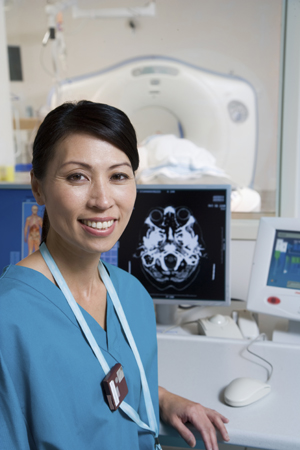Nuclear medicine is the branch of radiology that uses small amounts of radioactive material to diagnose or treat diseases. Nuclear scans can help doctors diagnose many conditions, including cancers, injuries and infections. They can also show how organs like your heart and lungs are working.
How it Works
 Nuclear scans involve a special camera that detects energy coming from the radioactive substance, called a radiotracer. Before the test, you receive the radiotracer, either by injection, by swallowing or inhaling a gas.
Nuclear scans involve a special camera that detects energy coming from the radioactive substance, called a radiotracer. Before the test, you receive the radiotracer, either by injection, by swallowing or inhaling a gas.
Nuclear medicine imaging procedures are noninvasive and usually painless medical tests.
Low-level radioactive chemicals used in these studies are taken up in different concentrations by different tissue types in your body. In cancer, for example, cells begin to grow at a much faster rate.
Special pictures are then produced on a computer showing the structure and function of internal body parts. During most nuclear scanning tests, you lie still on a scanning table while the camera makes images. Most scans take 20-45 minutes.
How the Scans Are Used
Nuclear medicine imaging scans are performed to:
- Locate an infection
- Analyze kidney function
- Look at blood flow to the heart and its function
- Scan the patient's lungs
- Study dementia
- Identify inflammation in the gallbladder
- Evaluate a stroke (blood clot or bleeding in the brain)
- Determine the presence or spread of cancer
- Find bleeding into the bowel
- Measure thyroid function
- Investigate abnormalities in the brain
- Localize lymph nodes before surgery
Nuclear Medicine Therapy
Nuclear medicine is also used to treat certain medical issues:
- Radioactive iodine therapy is used to treat hyperthyroidism (overactive thyroid gland) and thyroid cancer
- Radioactive antibodies are used to treat certain forms of lymphoma
- Radioactive phosphorus is used to treat some blood disorders
- Radioactive materials are used to treat painful tumor metastases to the bones
About safety
The risks associated with a nuclear medicine scan are small. The quantity of radiation is low and is quickly eliminated from the body through urine so that no detectable radioactivity is present after several hours. Family members are not at risk for exposure since greater than 90 percent of the radioactivity has left the body or decomposed before the patient leaves the hospital.
An allergic reaction to the radiotracer can occur, but allergic reactions are extremely rare and are usually mild. You should inform the nuclear medicine personnel of any allergies you have or other problems that may have occurred during a previous nuclear medicine test.
Inform your physician or radiology technologist if there is any possibility you are pregnant, or if you are breastfeeding.
How to Prepare for the Test
Wear loose-fitting clothing. You may be asked to change into a hospital gown. Jewelry and other metallic accessories should be left at home or removed before the test. They can interfere with the procedure.
What the Equipment Looks Like
Most nuclear medicine procedures are performed using a gamma camera, a specialized device that is capable of detecting radiation and taking pictures from different angles. It may be suspended over the examination table or it may be beneath the table. Often, gamma cameras are dual-headed with one camera above and one camera beneath the table. There is no specialized equipment used during radioactive iodine therapy, but the technologist or other personnel administering the treatment may cover your clothing and use lead containers to shield the radioactive material you will be receiving.
The Procedure
Most nuclear medicine procedures are painless and rarely have any side effects.
Depending upon the type of nuclear medicine test you are getting, the dose of radiotracer is injected intravenously, swallowed or inhaled as a gas.
If it is given intravenously, you will fee a slight prick when the needle is inserted. When the material is injected into your arm, you may feel a cold sensation moving up your arm.
If the radiotracer is swallowed, it has little or no taste. If it is inhaled, you should feel no differently than when breathing normally.
It can take anywhere from several seconds to several days for the radiotracer to travel through your body and accumulate in the organ or area being studied. As a result, imaging may be done immediately, a few hours later, or even several days after you have received the radioactive material.
A technologist helps you on the screening table and makes you comfortable. Once the test begins, you need to remain still until it is over. The technologist remains in the room with you until your test is finished.
About Radiation
The radiation doses used are very low. Patients only retain the low level of radioactivity administered during the test for a short time, and it is not harmful to the patient or individuals accompanying him or her.
When Your Test Is Complete
With our advanced software, your physician has access to your image and all of your clinical information almost immediately. Your images are read by a radiologist and your physician has a full report in 24-48 hours. You will then be contacted by your physician regarding the results.